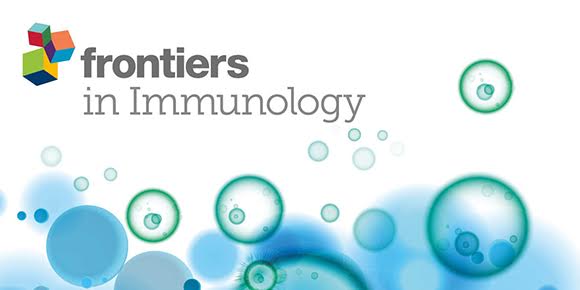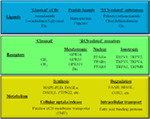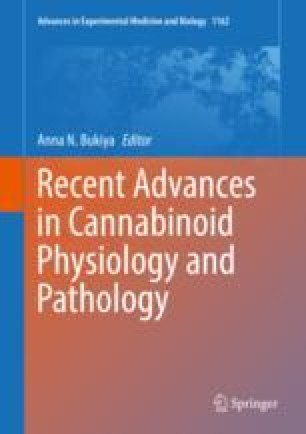 “It is well known that certain active ingredients of the plants of Cannabis genus, i.e., the “phytocannabinoids” [pCBs; e.g., (−)-trans-Δ9-tetrahydrocannabinol (THC), (−)-cannabidiol, etc.] can influence a wide array of biological processes, and the human body is able to produce endogenous analogs of these substances [“endocannabinoids” (eCB), e.g., arachidonoylethanolamine (anandamide, AEA), 2-arachidonoylglycerol (2-AG), etc.]. These ligands, together with multiple receptors (e.g., CB1 and CB2 cannabinoid receptors, etc.), and a complex enzyme and transporter apparatus involved in the synthesis and degradation of the ligands constitute the endocannabinoid system (ECS), a recently emerging regulator of several physiological processes. The ECS is widely expressed in the human body, including several members of the innate and adaptive immune system, where eCBs, as well as several pCBs were shown to deeply influence immune functions thereby regulating inflammation, autoimmunity, antitumor, as well as antipathogen immune responses, etc. Based on this knowledge, many in vitro and in vivo studies aimed at exploiting the putative therapeutic potential of cannabinoid signaling in inflammation-accompanied diseases (e.g., multiple sclerosis) or in organ transplantation, and to dissect the complex immunological effects of medical and “recreational” marijuana consumption. Thus, the objective of the current article is (i) to summarize the most recent findings of the field; (ii) to highlight the putative therapeutic potential of targeting cannabinoid signaling; (iii) to identify open questions and key challenges; and (iv) to suggest promising future directions for cannabinoid-based drug development.
“It is well known that certain active ingredients of the plants of Cannabis genus, i.e., the “phytocannabinoids” [pCBs; e.g., (−)-trans-Δ9-tetrahydrocannabinol (THC), (−)-cannabidiol, etc.] can influence a wide array of biological processes, and the human body is able to produce endogenous analogs of these substances [“endocannabinoids” (eCB), e.g., arachidonoylethanolamine (anandamide, AEA), 2-arachidonoylglycerol (2-AG), etc.]. These ligands, together with multiple receptors (e.g., CB1 and CB2 cannabinoid receptors, etc.), and a complex enzyme and transporter apparatus involved in the synthesis and degradation of the ligands constitute the endocannabinoid system (ECS), a recently emerging regulator of several physiological processes. The ECS is widely expressed in the human body, including several members of the innate and adaptive immune system, where eCBs, as well as several pCBs were shown to deeply influence immune functions thereby regulating inflammation, autoimmunity, antitumor, as well as antipathogen immune responses, etc. Based on this knowledge, many in vitro and in vivo studies aimed at exploiting the putative therapeutic potential of cannabinoid signaling in inflammation-accompanied diseases (e.g., multiple sclerosis) or in organ transplantation, and to dissect the complex immunological effects of medical and “recreational” marijuana consumption. Thus, the objective of the current article is (i) to summarize the most recent findings of the field; (ii) to highlight the putative therapeutic potential of targeting cannabinoid signaling; (iii) to identify open questions and key challenges; and (iv) to suggest promising future directions for cannabinoid-based drug development.
Active Components of Cannabis sativa (Hemp)—Phytocannabinoids (pCBs) and Beyond
It is known since ancient times that consumption of different parts of the plant Cannabis sativa can lead to psychotropic effects. Moreover, mostly, but not exclusively because of its potent analgesic actions, it was considered to be beneficial in the management of several diseases. Nowadays it is a common knowledge that these effects were mediated by the complex mixture of biologically active substances produced by the plant. So far, at least 545 active compounds have been identified in it, among which, the best-studied ones are the so-called pCBs. It is also noteworthy that besides these compounds, ca. 140 different terpenes [including the potent and selective CB2 agonist sesquiterpene β-caryophyllene (BCP)], multiple flavonoids, alkanes, sugars, non-cannabinoid phenols, phenylpropanoids, steroids, fatty acids, and various nitrogenous compounds can be found in the plant, individual biological actions of which are mostly still nebulous. Among the so far identified > 100 pCBs, the psychotropic (−)-trans-Δ9-tetrahydrocannabinol (THC) and the non-psychotropic (−)-cannabidiol (CBD) are the best-studied ones, exerting a wide-variety of biological actions [including but not exclusively: anticonvulsive, analgesic, antiemetic, and anti inflammatory effects]. Of great importance, pCBs have been shown to modulate the activity of a plethora of cellular targets, extending their impact far beyond the “classical” (see above) cannabinoid signaling. Indeed, besides being agonists [or in some cases even antagonists of CB1 and CB2 cannabinoid receptors, some pCBs were shown to differentially modulate the activity of certain TRP channels, PPARs, serotonin, α adrenergic, adenosine or opioid receptors, and to inhibit COX and lipoxygenase enzymes, FAAH, EMT, etc.. Moreover, from a clinical point-of-view, it should also be noted that pCBs can indirectly modify pharmacokinetics of multiple drugs (e.g., cyclosporine A) by interacting with several cytochrome P 450 (CYP) enzymes. Taken together, pCBs can be considered as multitarget polypharmacons, each of them having unique “molecular fingerprints” created by the characteristic activation/inhibition pattern of its locally available cellular targets.
Concluding Remarks—Lessons to Learn from Cannabis
Research efforts of the past few decades have unambiguously evidenced that ECS is one of the central orchestrators of both innate and adaptive immune systems, and that pure pCBs as well as complex cannabis-derivatives can also deeply influence immune responses. Although, many open questions await to be answered, pharmacological modulation of the (endo)cannabinoid signaling, and restoration of the homeostatic eCB tone of the tissues augur to be very promising future directions in the management of several pathological inflammation-accompanied diseases. Moreover, in depth analysis of the (quite complex) mechanism-of-action of the most promising pCBs is likely to shed light to previously unknown immune regulatory mechanisms and can therefore pave new “high”-ways toward developing completely novel classes of therapeutic agents to manage a wide-variety of diseases.”
https://www.frontiersin.org/articles/10.3389/fimmu.2017.01487/full


 “Agitation is a prevalent and difficult-to-treat symptom in patients with moderate-to-severe Alzheimer’s disease (AD). Though there are nonpharmacological and pharmacological interventions recommended for the treatment of agitation, the efficacy of these are modest and not always consistent. Furthermore, the safety profiles of currently prescribed medications are questionable.
“Agitation is a prevalent and difficult-to-treat symptom in patients with moderate-to-severe Alzheimer’s disease (AD). Though there are nonpharmacological and pharmacological interventions recommended for the treatment of agitation, the efficacy of these are modest and not always consistent. Furthermore, the safety profiles of currently prescribed medications are questionable. “The Cannabis plant has been used for many of years as a medicinal agent in the relief of pain and seizures. It contains approximately 540 natural compounds including more than 100 that have been identified as phytocannabinoids due to their shared chemical structure. The predominant psychotropic component is Δ9-tetrahydrocannabinol (Δ9-THC), while the major non-psychoactive ingredient is
“The Cannabis plant has been used for many of years as a medicinal agent in the relief of pain and seizures. It contains approximately 540 natural compounds including more than 100 that have been identified as phytocannabinoids due to their shared chemical structure. The predominant psychotropic component is Δ9-tetrahydrocannabinol (Δ9-THC), while the major non-psychoactive ingredient is  “Protocatechuic acid is an antioxidant which is shown to have analgesic activity in limited studies. However, the mechanisms of action remain unclear.
“Protocatechuic acid is an antioxidant which is shown to have analgesic activity in limited studies. However, the mechanisms of action remain unclear. “Osteoporosis is a skeletal disease with decreased bone mass and alteration in microarchitecture of bone tissue, and these changes put patients in risk of bone fracture. As a common symptom of osteoporosis and complication of osteoporotic fracture, chronic pain is a headache for clinicians. Nonsteroidal anti-inflammatory drugs (NSAIDs), selective COX-2 inhibitors and opioid drugs can temporarily reduce osteoporotic pain but have relevant side effects, such as addiction, tolerability and safety. The review summarized the recent advancements in the study of CB receptors in osteoporosis and osteoporotic pain and related mechanisms.
“Osteoporosis is a skeletal disease with decreased bone mass and alteration in microarchitecture of bone tissue, and these changes put patients in risk of bone fracture. As a common symptom of osteoporosis and complication of osteoporotic fracture, chronic pain is a headache for clinicians. Nonsteroidal anti-inflammatory drugs (NSAIDs), selective COX-2 inhibitors and opioid drugs can temporarily reduce osteoporotic pain but have relevant side effects, such as addiction, tolerability and safety. The review summarized the recent advancements in the study of CB receptors in osteoporosis and osteoporotic pain and related mechanisms.

 “Accumulating evidence supports the role of the cannabinoid system in providing an antinociceptive effect in various painful conditions.
“Accumulating evidence supports the role of the cannabinoid system in providing an antinociceptive effect in various painful conditions. “The cannabinoid receptor CB1 is involved in modulation of neuronal hypersensitivity and pain. The aim of this study was to evaluate CB1 receptor levels for the first time in dental pain. A total of 19 patients due for molar extraction were divided into two groups, those with existing dental pain (n=9), and those with no history of pain (n=10). Immunohistochemistry and computer image analysis was used to evaluate CB1-positive nerve fibres in tooth pulp, with neurofilament-immunostaining as a structural nerve marker. CB1-immunoreactive nerve fibres were scattered throughout the tooth pulp and often seen in nerve bundles, but the fibres did not penetrate the subodontoblastic layer. There was no statistically significant change in the CB1 nerve fibre percentage area in the painful group compared to the non-painful group (p=0.146); the neurofilament fibres were significantly reduced in the painful group compared to the controls (p=0.028), but there was no difference in the ratio of CB1 to neurofilaments between the two groups. Thus, CB1 expression is maintained by nerve fibres in painful human dental pulp, and peripherally-restricted CB1 agonists currently in development may advance the treatment of dental pain.”
“The cannabinoid receptor CB1 is involved in modulation of neuronal hypersensitivity and pain. The aim of this study was to evaluate CB1 receptor levels for the first time in dental pain. A total of 19 patients due for molar extraction were divided into two groups, those with existing dental pain (n=9), and those with no history of pain (n=10). Immunohistochemistry and computer image analysis was used to evaluate CB1-positive nerve fibres in tooth pulp, with neurofilament-immunostaining as a structural nerve marker. CB1-immunoreactive nerve fibres were scattered throughout the tooth pulp and often seen in nerve bundles, but the fibres did not penetrate the subodontoblastic layer. There was no statistically significant change in the CB1 nerve fibre percentage area in the painful group compared to the non-painful group (p=0.146); the neurofilament fibres were significantly reduced in the painful group compared to the controls (p=0.028), but there was no difference in the ratio of CB1 to neurofilaments between the two groups. Thus, CB1 expression is maintained by nerve fibres in painful human dental pulp, and peripherally-restricted CB1 agonists currently in development may advance the treatment of dental pain.”